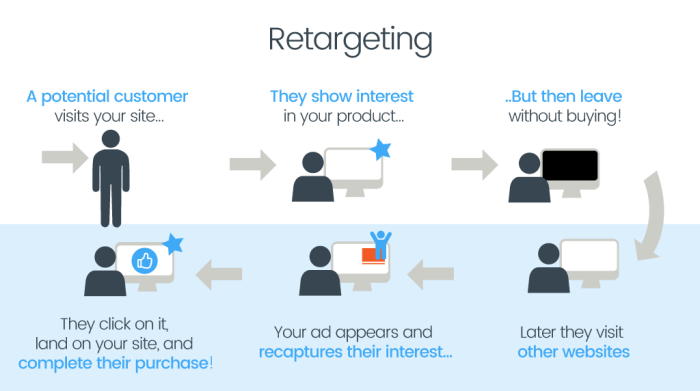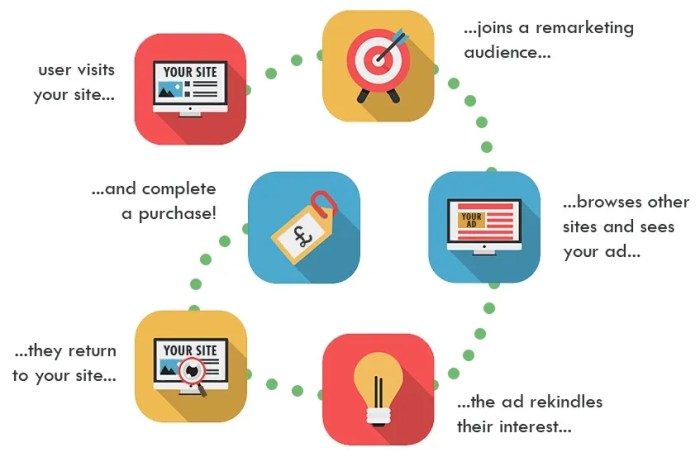Using Retargeting Ads takes center stage, drawing you into a world where businesses thrive on targeted advertising. Get ready to dive into the realm of digital marketing with a twist!
From understanding the basics to mastering the art of retargeting, this guide will equip you with the knowledge needed to elevate your marketing game.
Introduction to Retargeting Ads: Using Retargeting Ads

Retargeting ads, also known as remarketing, are a digital marketing strategy that involves targeting ads to users who have previously visited a website or interacted with a brand online. These ads work by tracking users’ online behavior through cookies and then displaying targeted ads to them as they browse other websites or social media platforms.
Benefits of Retargeting Ads, Using Retargeting Ads
- Increased Brand Awareness: Retargeting ads help keep your brand top of mind for potential customers who have shown interest in your products or services.
- Higher Conversion Rates: By targeting users who are already familiar with your brand, retargeting ads can lead to higher conversion rates compared to traditional advertising methods.
- Cost-Effective: Retargeting ads can be a cost-effective way to reach users who are more likely to convert, as you are targeting a warm audience rather than a cold one.
Examples of Industries Using Retargeting Ads
- E-commerce: Online retailers can benefit from retargeting ads to remind users of products they viewed but did not purchase.
- Travel: Travel agencies can use retargeting ads to entice users who have researched trips but have not yet booked.
- Real Estate: Real estate agents can use retargeting ads to target users who have visited property listings but have not made inquiries.
Importance of Retargeting Ads in Digital Marketing
Retargeting ads play a crucial role in a digital marketing strategy as they help businesses stay connected with potential customers and guide them through the conversion funnel. By targeting users who have already shown interest in a brand, retargeting ads can significantly increase the chances of conversion and drive more sales.
Types of Retargeting Ads
When it comes to retargeting ads, there are several types that marketers can leverage to reconnect with potential customers who have shown interest in their products or services. Each type has its own advantages and disadvantages, making it important to understand how they work and when to use them strategically.
Pixel-Based Retargeting
Pixel-based retargeting involves placing a small piece of code, known as a pixel, on your website. This pixel tracks visitors and their behavior, allowing you to display targeted ads to them as they browse other websites or social media platforms. The main advantage of pixel-based retargeting is its ability to reach a larger audience and increase brand visibility. However, some users may find this type of retargeting intrusive, leading to concerns about privacy.
List-Based Retargeting
List-based retargeting involves uploading a list of contacts, such as email addresses or phone numbers, to a retargeting platform. The platform then matches these contacts to its user database and displays ads to those individuals. This type of retargeting is highly targeted and personalized, making it effective in reaching a specific audience. However, the success of list-based retargeting depends on the quality of the contact list and the accuracy of the matching process.
Email Retargeting
Email retargeting involves sending personalized emails to individuals who have visited your website but did not make a purchase. These emails can contain product recommendations, special offers, or reminders to complete their purchase. The advantage of email retargeting is its direct and personal approach, which can help re-engage customers and drive conversions. However, overuse of email retargeting can lead to email fatigue and unsubscribes.
Examples of successful campaigns using each type of retargeting ad:
– Pixel-Based Retargeting: An e-commerce company used pixel-based retargeting to show ads of abandoned cart items to visitors who left the website without completing their purchase. This strategy led to a 20% increase in conversion rates.
– List-Based Retargeting: A travel agency uploaded a list of previous customers’ email addresses and targeted them with ads for upcoming vacation deals. This resulted in a 15% increase in repeat bookings.
– Email Retargeting: A clothing retailer sent personalized emails to customers who viewed specific products but did not make a purchase. By including limited-time discounts in the emails, they saw a 25% increase in sales.
Setting up Retargeting Campaigns

Setting up retargeting campaigns on popular platforms like Google Ads, Facebook, or AdRoll involves a few key steps to ensure your ads reach the right audience and drive conversions effectively.
Audience Segmentation and Targeting
When setting up retargeting campaigns, it’s crucial to segment your audience based on their interactions with your website or previous engagement with your brand. This allows you to tailor your ad messaging to specific groups of users, increasing the likelihood of conversion.
- Segment your audience based on the pages they visited on your website, products they viewed, or actions they took (such as adding items to their cart but not completing the purchase).
- Use demographic data, interests, and behaviors to further refine your audience segments and create personalized ads that resonate with each group.
- Exclude converted customers or users who have already completed the desired action to ensure you’re not wasting ad spend on irrelevant audiences.
Creating Compelling Ad Creatives
To make your retargeting ads stand out and capture the attention of your audience, it’s essential to create compelling ad creatives that entice users to click and revisit your website.
- Use eye-catching visuals and compelling copy that highlights the value proposition of your products or services.
- Include a clear call-to-action that directs users to take the next step, whether it’s making a purchase, signing up for a newsletter, or requesting more information.
- Test different ad formats, messaging, and visuals to see what resonates best with your audience and drives the highest conversion rates.
Retargeting Ad Metrics and Analysis
When it comes to measuring the success of retargeting ads, there are several key performance indicators (KPIs) that you should keep an eye on. These metrics will help you understand how well your campaigns are performing and where you can make improvements.
Key Performance Indicators for Retargeting Ads
- Click-Through Rate (CTR): This metric measures the percentage of people who click on your retargeting ad after seeing it. A high CTR indicates that your ad is engaging and relevant to your audience.
- Conversion Rate: The conversion rate shows the percentage of people who take a desired action, such as making a purchase or signing up for a newsletter, after clicking on your retargeting ad.
- Return on Ad Spend (ROAS): ROAS calculates the revenue generated from your retargeting ads compared to the amount spent on them. It helps you understand the profitability of your campaigns.
Analyzing Data for Optimization
It’s crucial to analyze data from your retargeting campaigns to identify trends, patterns, and areas for improvement. By looking at metrics like CTR, conversion rate, and ROAS, you can make informed decisions to optimize your ad performance.
Importance of A/B Testing
- A/B testing involves creating multiple versions of your retargeting ads to see which one performs better. By testing different ad copy, images, or calls-to-action, you can determine what resonates most with your audience.
- Through A/B testing, you can gather valuable insights into what works and what doesn’t, allowing you to refine your retargeting campaigns for maximum effectiveness.
